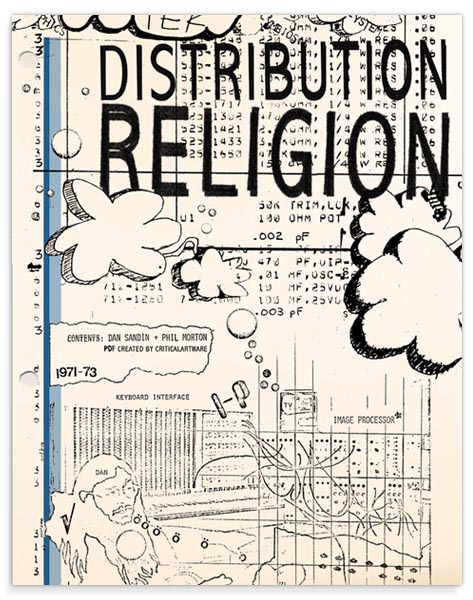



The early experimental video art scene in Chicago, and its indispensability in developing an understanding of contemporary New Media practices, is something that I learned from jonCates and that jonCates learned from Phil Morton. Well, maybe it’s not quite that simple, but that is one possible set of connections that can be traced from jonCates’ COPY-IT-RIGHT project.
The Phil Morton Memorial Research Archive was initiated in 2007 by jonCates and is housed in The Film, Video & New Media Department at the School of the Art Institute of Chicago. It exists to organize and freely distribute Phil Morton’s new media artwork, and also to perpetuate the COPY-IT-RIGHT ideal that Morton advocated. As you can read on the blog for the COPY-IT-RIGHT project, Morton sought to disseminate an anti-copyright attitude towards media and its distribution, especially artwork that is based in digital technologies. By referencing these ideals under the phrase ‘COPY-IT-RIGHT’, Morton sought to completely replace ingrained notions of copyright law by re-framing the term’s meaning as a call to action. Make copies! It’s the right thing to do! jonCates states that COPY-IT-RIGHT ranges in meaning from copyright reform to pro-piracy. “The COPY-IT-RIGHT ethic is presented by Morton as a value, even as a moral imperative, to share and freely exchange media,” he said.
jonCates began researching Morton’s work shortly before he learned of Morton’s death from Jane Veeder, one of Morton’s collaborators. Veeder put him in contact with Morton’s surviving partner, Barb Abramo, who later entrusted all of Morton’s archived material to him. jonCates said that this took place after a couple years of correspondence and a developed understanding. The creation of the archive is, “a personal and subjective process that involves developing trust and friendships.”
The personal degrees of separation enabling this archive, however, should not betray it’s larger goal, which, according to jonCates, is to facilitate discourse. “This discursive work is intended to be productive, engendering the development of theory/practices that are informed by these archives and contributing to ongoing conversations,” he states. The archive is a central point of investigation, but also exists as a mediating voice within existing networks and issues, in both form and content. The intermingling of the archive’s personal and institutional roots is exemplary of how individual archives might begin to bridge recognized authority and the histories that are important to individuals.
Because COPY-IT-RIGHT is a project that seeks to freely distribute media art, as well as create a networked discourse around it, we are invited to explore ideas such as influence and the generative origins of our knowledge. This process eclipses antiquated visions of the archive as a static source of ‘knowledge’ or ‘history’.
COPY-IT-RIGHT’s latest web entry is a transcript of a talk jonCates gave at McGill University on anti-copyright approaches to media. In that talk, he refers to “the artistic role of archives”. jonCates provided some further examples of “artistic archives”, such as Emily Jacir’s Material for a Film and Walid Raad’s The Atlas Group, which both seek to illuminate history and contemporary contexts through materials that might not be automatically absorbed into our stateliest cultural institutions. They represent an independent approach to information collection, at the same time that they contain material that is itself a challenge to dominant cultural and historical knowledge. Likewise, COPY-IT-RIGHT is a lesser-voiced exploration of Chicago’s art history, but also an open-ended call to discuss and develop material on the future of media copyright attitudes.
The COPY-IT-RIGHT project, as mentioned, also exists to provide entry into Morton’s media art, for study or copy. The work he did with Dan Sandin, creator of the Sandin Image Processor – an analog computer for video image processing. Morton and Sandin’s “Distribution Religion” is a project that documents the process of duplicating the Sandin Image Processor. Morton wanted to create a duplicate of the processor itself, and in the process, created an outline of the method for others. The documentation became part of the copying process, and also includes remarks on the COPY-IT-RIGHT ethic.

The Distribution Religion is archived on giorgiomagnanensi.com. Examining this document and reading its prefatory statements seem to get at the heart of COPY-IT-RIGHT’s significance. jonCates is interested in the fact that Morton and Sandin’s work “predates The Pirate Party, Free and Open Source Software, Creative Commons and/or the Digital Millennium Copyright Act.” Although most copyright initiatives are steeped in political and legal challenges, COPY-IT-RIGHT offers an inaugural stance on issues that are at the forefront of contemporary culture: interdisciplinary desires, open information, and the democratic malleability of our cultural memory.
We have come to expect that information is distributed, and available. But we don’t necessarily employ it for our own purposes with the intent of ‘copying’ it. But this is, in essence, a direct form of preservation. In a 2004 lecture, Florian Cramer cited a parallel between artists who step outside of copyright law, and the sciences. Scientists, he says, have mostly been free to use formulas and proofs in the generation of new discoveries. In this light ‘copying’ has now become synonymous with ‘usage’ and the natural role this plays in the development of ideas become even more obvious. COPY-IT-RIGHT, by existing as an explicitly anti-copyright project and by making Morton’s materials available for the generation of new works, aligns the idea of copying with progress rather than piracy or plagiarism. As jonCates states in his own lecture, the ethic “opposed private property, ownership and economic exploitation on the basis of technologies.” COPY-IT-RIGHT suggests that the availability of resources is, as jonCates puts it, “not simply for study, but also for creative cultural uses by artists.”